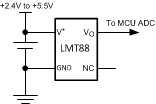SNIS175A March 2013 – January 2015 LMT88
PRODUCTION DATA.
- 1 Features
- 2 Applications
- 3 Description
- 4 Revision History
- 5 Pin Configuration and Functions
- 6 Specifications
- 7 Detailed Description
- 8 Application and Implementation
- 9 Power Supply Recommendations
- 10Layout
- 11Device and Documentation Support
- 12Mechanical, Packaging, and Orderable Information
Package Options
Mechanical Data (Package|Pins)
- DCK|5
Thermal pad, mechanical data (Package|Pins)
Orderable Information
1 Features
2 Applications
- Industrial
- HVAC
- Disk Drives
- Automotive
- Portable Medical Instruments
- Computers
- Battery Management
- Printers
- Power Supply Modules
- FAX Machines
- Mobile Phones
- Automotive
3 Description
The LMT88 device is a precision analog output CMOS integrated-circuit temperature sensor that operates over a temperature range of −55°C to 130°C . The power supply operating range is 2.4 V to 5.5 V. The transfer function of LMT88 is predominately linear, yet has a slight predictable parabolic curvature. The accuracy of the LMT88 when specified to a parabolic transfer function is typically ±1.5°C at an ambient temperature of 30°C. The temperature error increases linearly and reaches a maximum of ±2.5°C at the temperature range extremes. The temperature range is affected by the power supply voltage. At a power supply voltage of 2.7 V to 5.5 V, the temperature range extremes are 130°C and −55°C. Decreasing the power supply voltage to 2.4 V changes the negative extreme to −30°C, while the positive remains at 130°C.
The LMT88 quiescent current is less than 10 μA. Therefore, self-heating is less than 0.02°C in still air. Shutdown capability for the LMT88 is intrinsic because its inherent low power consumption allows it to be powered directly from the output of many logic gates or does not necessitate shutdown at all.
The LMT88 is a cost-competitive alternative to thermistors.
Device Information(1)
| PART NUMBER | PACKAGE | BODY SIZE (NOM) |
|---|---|---|
| LMT88 | SOT (5) | 2.00 mm × 1.25 mm |
- For all available packages, see the orderable addendum at the end of the datasheet.
Simplified Schematic

Output Voltage vs Temperature
